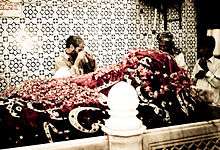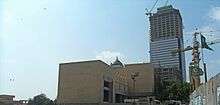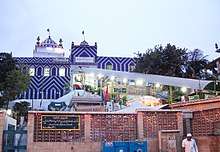Abdullah Shah Ghazi
- See also Ghazi and Gazi (disambiguation)
Abdullah Shah Ghazi (Arabic: عبد الله شاه غازي) (c. 720) was an eighth-century Muslim mystic and Sufi whose shrine is located in the Clifton neighbourhood of Karachi, Pakistan.[1]
Life

According to the city of Karachi's historian and architect, Suhail Lari, being the son of Muhammad al-Nafs al-Zakiyya, Abdullah Shah Ghazi was of the Ahl al-Bayt (member of the household of Muhammad).[2] He was born in Medina in 720 and arrived in Sindh as an Arab merchant. Another noted historian, M. Daudpota, says that Ghazi came to the area from Iraq with Muhammad bin Qasim's army and took part in fighting Sindh's Hindu ruler Raja Dahir in the seventh century.[3] Abdullah Shah Ghazi was said to have been killed by enemies in a forest, with devotees returning his body to a site on the coast where he is said to have first stepped foot in Sindh.[3] He was buried atop a hillock in Karachi along with his brother Misry Shah.[4]
Shrine

The tomb is built on a high platform, though the body is kept in a subterranean crypt. The shrine is made of a high, square chamber and a green-and-white striped dome, decorated with Sindhi tilework, flags and buntings. The shrine attracts a steady stream of devotees who caress the silver railing around the burial place and drape it with garlands of flowers. The shrine is said to be particularly popular with Urdu-speakers and Punjabis. As a sign of cooperation among different faiths, some Christian and Hindu community members are occasionally seen also at the shrine.[3]
Until the early 1950s, the shrine was a small hut on top of a sandy hill in Clifton. The shrine was built, expanded and beautified by the then custodian of the shrine, Murshid Nadir Ali Shah[5] in the mid-1950s, as it had begun to attract devotional attention. The shrine expansion and pilgrims attracted the festivities, free meals for all and the devotional music such as Qawwali.[1] In 1962, The Auqāf department took administrative control of the shrine. In 2011, the shrine was handed over to a private company, M/s Bahria.[6]
Abdullah Shah Ghazi shrine was attacked in 2010 by militants who detonated two suicide bombs at the shrine, killing 10 and injuring 50.[3]
The shrine's management is still able to provide two daily meals free to anyone in need.[1]
See also
- List of mausoleums and shrines in Pakistan
- Muhammad al-Nafs al-Zakiyya, descendant of Imam Hasan ibn Ali
- Gazi Pir
References
- 1 2 3 Asim Butt (August 11, 2005). "Pakistan's mystical Islam thrives". BBC News. Archived from the original on May 8, 2009. Retrieved 12 February 2018.
- ↑ Lari, Suhail Zaheer. A History of Sindh. Oxford University Press, USA. 1995, np [and OUP Pakistan, 1996.]
- 1 2 3 4 Paracha, Nadeem (23 November 2014). "Abdullah Shah Ghazi: The saviour saint". Dawn (newspaper). Retrieved 12 February 2018.
- ↑ Profile of Abdullah Shah Ghazi Retrieved 12 February 2018
- ↑ ummat.net https://www.ummat.net/2016/09/29/news.php?p=story4.gif. Retrieved 2018-02-21. Missing or empty
|title=(help) - ↑ "Takeover of shrines: Private company to run Abdullah Shah Ghazi - The Express Tribune". tribune.com.pk. Retrieved 2018-02-13.
